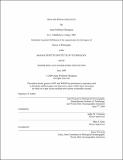Iron and Prochlorococcus/
Author(s)
Thompson, Anne Williford
DownloadFull printable version (12.60Mb)
Other Contributors
Woods Hole Oceanographic Institution.
Advisor
Sallie W. Chisholm and Mak A. Saito.
Terms of use
Metadata
Show full item recordAbstract
Iron availability and primary productivity in the oceans are intricately linked through photosynthesis. At the global scale we understand how iron addition induces phytoplankton blooms through meso-scale iron-addition experiments. At the atomic scale, we can describe the length and type of bonds that connect iron atoms to components of photosystem I, the most efficient light-harvesting complex in nature. Yet, we know little of how iron influences microbial diversity and distribution in the open ocean. In this study, we assess the influence of iron on the ecology of the numerically abundant marine cyanobacterium, Prochlorococcus. With its minimal genome and ubiquity in the global ocean, Prochlorococcus represents a model system in which to study the dynamics of the link between iron and primary productivity. To this end, we tested the iron physiology of two closely-related Prochlorococcus ecotypes. MED4 is adapted to high-light environments while MIT9313 lives best in low-light conditions. We determined that MIT9313 is capable of surviving at low iron concentrations that completely inhibit MED4. Furthermore, concentrations of Fe' that inhibit growth in culture are sufficient to support Prochlorococcus growth in the field, which raises questions about the species of iron available to Prochlorococcus. We then examined the molecular basis for the ability of MIT9313 to grow at lower iron concentrations than MED4 by assessing whole-genome transcription in response to changes in iron availability in the two ecotypes. Genes that were differentially expressed fell into two categories: those that are shared by all (Prochlorococcus core genome) and those that are not (non-core genome). Only three genes shared between MED4 and MIT9313 were iron-responsive in both strains. We then tested the iron physiology of picocyanobacteria in the field and found that Synechococcus is iron-stressed in samples where Prochlorococcus is not. Finally, we propose a method to measure how iron stress in Prochlorococcus changes over natural gradients of iron in the oligotrophic ocean by quantifying transcription of the iron-stress induced gene, isiB. Taken together, our studies demonstrate that iron metabolism influences the ecology of Prochlorococcus both by contributing to its diversity and distinguishing it from other marine cyanobacteria.
Description
Thesis (Ph. D.)--Joint Program in Biological Oceanography (Massachusetts Institute of Technology, Dept. of Biology; and the Woods Hole Oceanographic Institution), 2009. Includes bibliographical references.
Date issued
2009Department
Joint Program in Biological Oceanography.; Woods Hole Oceanographic Institution; Massachusetts Institute of Technology. Department of BiologyPublisher
Massachusetts Institute of Technology
Keywords
Joint Program in Biological Oceanography., Biology., Woods Hole Oceanographic Institution.